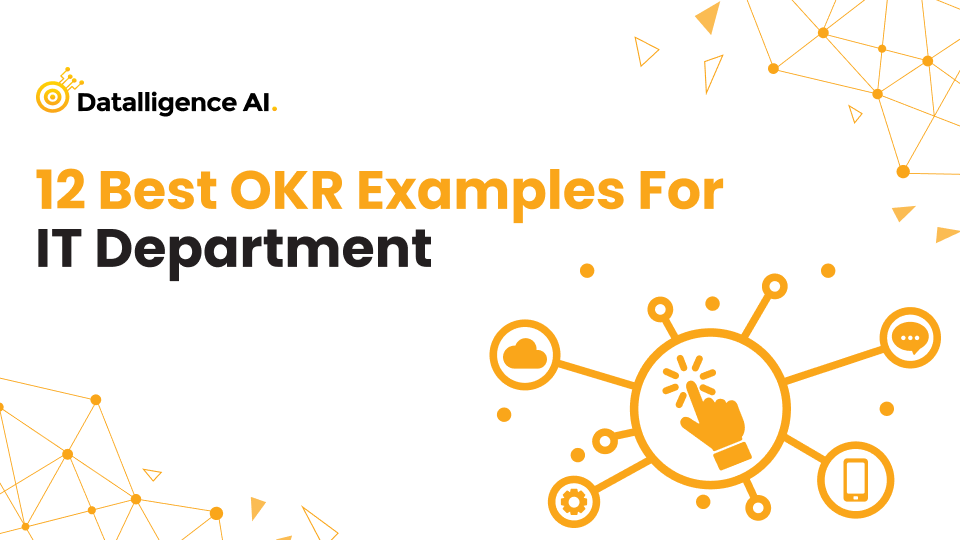In the rapidly evolving IT sector, it’s crucial to implement OKR for the IT department to establish a well-structured framework for defining and assessing IT objectives. This guide offers a variety of OKRs examples and templates for the IT department to help you boost the efficiency and productivity of your IT team.
Our curated collection of OKR examples for IT department encompasses a diverse range of objectives, spanning from enhancing cybersecurity to streamlining infrastructure and expediting product development. By leveraging these practical examples, you can craft tailored IT department OKRs aligned with your specific goals and propel success in the digital realm.
Whether you’re an IT manager, a CTO, or a team lead, this guide equips you with the insights and inspiration needed to develop customized IT OKRs for your IT department and OKRs for IT department that lead your department to greater efficiency and innovation in this rapidly changing industry. Unlock the potential of “OKRs for your IT department’s success” with these examples.
OKRs for Security
Objective: Secure digital platforms for remote employees
- Key Result 1: Finish a penetration test before the end of Q1.
- Key Result 2: Ensure that the organization’s current backup solutions are used 100%.
- Key Result 3: Do a competitive analysis report by the end of the second quarter.
- Key Result 4: Attain 100% uptime at the end of the second quarter.
Objective: Improve control and management of the IT security incident response system
- Key Result 1: Upgrade reporting frequency from 5 to 9 times per quarter from the critical incident response center (CIRC).
- Key Result 2: Ensure that each end-user attends two training sessions on security breach response per quarter.
- Key Result 3: Reduce the length of service outages from 4 hours to 1 hour.
Objective: Enhance the data disaster recovery process
- Key Result 1: Increase the number of data centers in the EU region by twofold.
- Key Result 2: Reduce the time it takes to backup data from 120 minutes to 30 minutes.
- Key Result 3: Expand the number of disaster recovery sites from three to five.
Objective: Develop critical skills and raise awareness about cybersecurity
- Key Result 1: Increase the number of quarterly cybersecurity awareness training sessions from one to two.
- Key Result 2: Reduce the number of attempts per employee to access unauthorized web pages from 25 to 10 to improve productivity.
- Key Result 3: Reduce the percentage of end-users who open phishing emails from 6% to 1%.
Objective: Enhance protection against antivirus
- Key Result 1: Increase the percentage of computers with antivirus software installed from 95% to 100%.
- Key Result 2: Increase the percentage of systems with the most recent antivirus definitions installed from 90% to 98%.
- Key Result 3: Reduce the number of SSL certificates incorrectly configured from 8 to 1.
Objective: Enhance the process of incident management
- Key Result 1: Increase the size of the dedicated incident response team from five to ten members.
- Key Result 2: Reduce mean time to resolution (MTTR) for severity two incidents from 120 to 90 minutes.
- Key Result 3: Reduce the number of monthly recurring incidents from 25 to 3 (through KMDB).
- Key Result 4: Reduce the mean quarterly downtime for security incidents from 40 minutes to 10 minutes.
OKRs for Infrastructure
Objective: Manage network infrastructure in an efficient manner
- Key Result 1: Enhance performance management of WAN links by reducing the number of WAN bottlenecks from ten to five per quarter.
- Key Result 2: Reduce the average ticket handling time for an infrastructure service per user from 18 hours to 6 hours this quarter.
- Key Result 3: Reduce the time required to resolve network infrastructure problems from 36 to 10 hours on average.
Objective: Enhance maintenance and installation of hardware assets
- Key Result 1: Grow the hardware installation and maintenance team from 3 to 6 employees in Q2.
- Key Result 2: Discard redundant and outdated hardware by the end of the quarter.
- Key Result 3: Increase the number of authenticated users who are granted access to server rooms from 2 to 4.
OKRs for Product
Objective: Enhance system stability
- Key Result 1: Strengthen Mean Time Between Failures (MTBF) to 60 days.
- Key Result 2: Reduce MTTR to 15 minutes.
- Key Result 3: Perform an environment audit once every 21 days.
- Key Result 4: Improve test coverage to 75%.
Objective: Accelerate IT development
- Key Result 1: Increase the monthly number of merge requests from 5 to 7.
- Key Result 2: Reduce the Mean Time to Production to three days.
- Key Result 3: Increase the number of Merge Requests per engineer across all teams by 40%.
- Key Result 4: Reduce merge request review time by 40%.
Objective: Deliver timely features to enterprise customers
- Key Result 1: Attain a maintainer-to-developer ratio of 1:15.
- Key Result 2: Address all enterprise-wide priority issues on a timely basis.
- Key Result 3: Identify and deliver five critical performance improvements.
Objective: Reduce financial and IT department costs
- Key Result 1: Reduce quarterly asset maintenance costs from $350 to $200.
- Key Result 2: Reduce infrastructure costs per employee in the current quarter from $300 to $150.
- Key Result 3: Reduce the cost of training per user from $11,000 to $700 per user.
Conclusion
Setting effective OKRs is essential for driving success in IT initiatives. Whether you’re focused on enhancing security measures, improving infrastructure, or accelerating product development, the examples provided in this comprehensive guide will serve as a valuable resource. Remember, the key to achieving your objectives is to ensure they are specific, measurable, attainable, relevant, and time-bound. So, get started today and take your IT department to new heights with the power of OKRs.
For more information on how to implement OKRs in your organization, contact Datalligence.ai, your trusted partner in IT strategy and execution.











